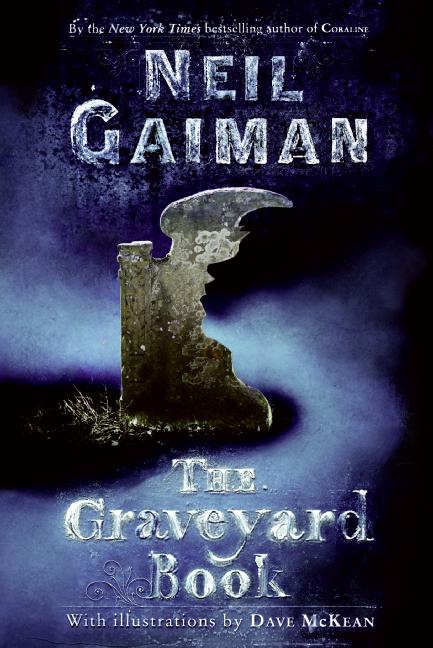This review was originally posted on October 7th, 2008. Neil Gaiman’s The Graveyard Book is a 2009 Hugo Award nominee for Best Novel.
Were there but world enough and time, I would have read the complete works of Neil Gaiman by now. In the interest of full disclosure, however, I should admit that I have not read everything the man’s ever written (he is, after all, an exceedingly prolific author/poet/screenwriter, not to mention a near-obsessive blogger) and even Tor employees have to sleep once in awhile). Happily, I have read more than enough to know of Gaiman’s fondness for quoting T.S. Eliot now and again, particularly “Whispers of Immortality,” which begins “Webster was much possessed by death/And saw the skull beneath the skin…”
Gaiman’s latest novel, The Graveyard Book (HarperCollins), is an affectionate homage to Rudyard Kipling’s The Jungle Book channeled through Webster’s morbid aesthetic. Aimed at both younger and adult readers alike (much like the 2002 novella Coraline), the story opens on a dark night, following a shadowy assassin as he calmly and dispassionately slaughters a sleeping family one by one. In spite of his evident skill and clinical, professional precision, the murderer fails to dispatch his final target, a baby boy who toddles to safety in the darkness of a nearby cemetery, granted sanctuary by its ghostly inhabitants. Christened “Nobody Owens” by his kindly, long-dead adoptive parents, Bod is granted free rein and protection within the graveyard, although ever-present danger lurks beyond its gates in the world of the living. From there, the story progresses more or less along the lines of a standard coming-of-age tale, as Bod grows from a clear-eyed, curious child into a young man attempting to establish his identity at the slippery crossroads between the living and the dead, youth and adulthood.
As in The Jungle Book, most chapters can be read as stand-alone vignettes chronicling key episodes in Bod’s development, as we encounter in turn the various quirky denizens of the graveyard who act as the boy’s teachers, tutors, counselors and friends. I should note that while familiarity with the two volumes of The Jungle Book isn’t a prerequisite for enjoying the world Gaiman creates, the author himself suggests in his acknowledgements that those who haven’t read the stories should give them a look, pointing out that the originals are really quite different from the popular Disney version. (One might be surprised to learn, for example, that the monkeys in Kipling’s stories are not in fact commanded by a scat-singing Louis Prima in ape form—who knew?). In the end, however, it is not Kipling’s influence but Webster’s that gives Gaiman’s writing its power—a power which lies in the nuances that elevate Bod’s story from a straightforward bildungsroman to a subtle meditation on loss, change, identity, and imagination as a moral imperative.
Discussing the book on his blog, Gaiman writes:
It’s not that easy to describe. I’m reminded of Kim Newman’s review of Anansi Boys, which began “Anansi Boys is one of Neil Gaiman’s books for grown-ups, which means that it’s a lot less ruthless than the material he produces for children”, and it’s a very true observation. From that perspective, it’s definitely one of my children’s books.
Like most great children’s authors, Gaiman pairs an implicit understanding of and respect for the intelligence of the young with a keen eye for the familiar foibles and myopic tendencies of adult characters, who often talk in unhelpful platitudes, dispense dubious advice, and exhibit a penchant for being utterly pigheaded at times. Which is not to say that he favors one side at the expense of the other; this book is more than anything else a story about boundaries, about being caught between worlds and negotiating a place in which one can finally belong, and so Gaiman distributes goodness and badness fairly evenly amongst young and old, living and dead alike, creating a rather satisfying continuum of kindness and pettiness, intelligence and stubbornness, wrongdoing and redemption through which Bod must navigate the process of coming into his own.
The novel’s highly descriptive prose captures perfectly the bleakness of cold autumn wind blowing through cemetery trees and lonely winter nights spent alone under a high, pale moon, but unlike Webster and Eliot, Gaiman keeps his metaphysics warm throughout, finding tenderness and hope in what would seem the most hopeless of surroundings. In a pivotal conversation with Silas, his undead guardian, Bod is made startlingly aware of the advantages of being young and alive, in stark contrast to the world around him:
“You’re alive, Bod. That means you have infinite potential. You can do anything, make anything, dream anything. If you change the world, the world will change. Potential.”
For Gaiman, the skull beneath the skin serves less as a memento mori than a reminder that life is for the living and as a symbol of the awesome potential inherent in vitality, youth and imagination. As the action culminates in the last several chapters of the book, Bod begins to fully realize that potential—a process which is not without cost and consequences. Just as he starts to appreciate the benefits of being shielded from the hazards of the world, he must also face the fact that the protective safety and familiarity of his childhood home has suddenly become an obstacle impeding his further growth. The Graveyard Book is more than an excellent tale of adventure, revenge, and revelation; it is both an elegy and a celebration of people and things lost and found on the journey into adulthood, the sacrifices we all make in order to be the people we need to become. Neil Gaiman has once again deftly crafted a work which speaks without condescension to the experience of children—with all the future ahead of them, equally daunting and miraculous—and with sympathy and intelligence to those who will recognize with a certain bittersweetness some of their past in the triumphs and travails of Nobody Owens.










